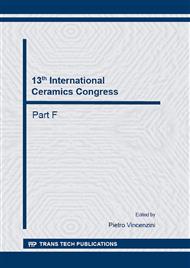p.1
p.8
p.14
p.20
p.26
p.32
p.38
p.44
Alkali-Activated Fly Ash Foams – Synthesis, Chemo-Physical Properties and Microstructure Modeling
Abstract:
Inorganic foams offer several unique properties such as low thermal conductivity, fire resistance, or UV stability. Inorganic foam specimens were synthesized from fly ash and aluminium powder through an alkali-activation process. Depending on mix proportions, bulk densities ranged between 400 and 800 kg/m3. Thermal treatment at 80°C for 12 hours accelerated curing process. Compressive strength was found in the range 4.5-9.0 MPa, flexural strength 0.6-1.7 MPa, Young's modulus 0.6-1.1 GPa, thermal conductivity 0.14-0.16 W/m/K and thermal capacity around 1100 J/kg/K. Exposing the foams to temperature 800°C led to a small decrease of compressive strength while exposure to 1100°C sintered the foam to higher strength of 13 MPa. Volumetric shrinkage 20% occurred at 1100°C without further disintegration. Residual compressive strength was determined after exposure to NaCl, HCl, Na2SO4, MgSO4, H2SO4. The highest reduction to 20% occured in both acids with pH=2 after one year of exposition. Digitized microstructures entered finite element analysis to validate a stress-strain diagram.
Info:
Periodical:
Pages:
14-19
Citation:
Online since:
October 2014
Authors:
Keywords:
Price:
Сopyright:
© 2014 Trans Tech Publications Ltd. All Rights Reserved
Share:
Citation:


